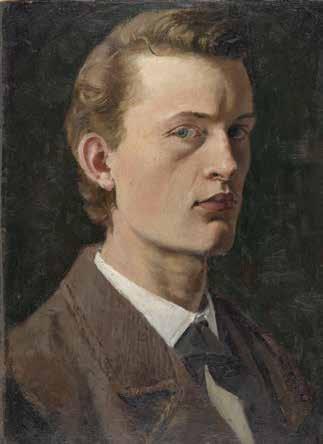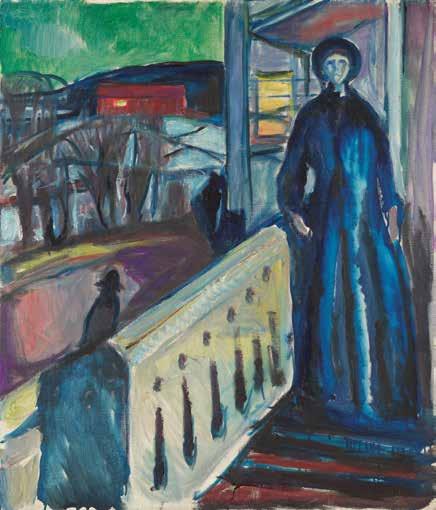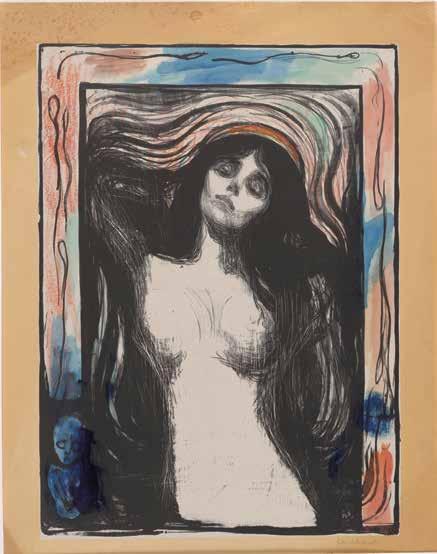




















by Micaela Zucconi
Symbolist and pioneer of Expressionism, the Norwegian artist, one of the most iconic artists of his time, used vibrant tints to express strong, universal emotions


Opening, Edvard Munch, Desperation, 1894, oil on canvas.
This page, Edvard Munch, Self portrait, 1881-82, oil on board; right, Edvard Munch, On the Veranda Stairs, 1922–24, oil on canvas

Art lovers seeking a full-on experience of the work of Edvard Munch (18631944) should visit the Munch Museum in Oslo, which houses the world’s largest collection of works by the prolific artist, famous for “The Scream”. It is home to 1,100 paintings, 3,000 drawings and 18,000 lithographs, displayed in rotation. In the meantime, a selection of 100 masterworks is on display at the Palazzo Bonaparte in Rome until 2nd June in the exhibition “Munch. The Inner Scream”, produced and organised by Arthemisia. The show explores Edvard Munch’s artistic journey in seven sections, covering the crucial stages of his life. Regarded as one of the most important exponents of Modernism, his long career saw him as a part of the Symbolist movement around 1890 and then a pioneer of Expressionism in the early 20th century. Munch’s activities ranged from painting to sculpture, drawing and graphics to photography and film. At the age of 17, already confronting a number of challenges and dealing with familial strife, he wrote in his diary, “My destiny is now to become a painter”. Born in Løten, he grew up in Kristiania, modern-day Oslo. He lost his mother at a very young age when she died of tuberculosis, and the same disease carried off his sister some years later, while his


father died of a stroke in 1889. His own health was not robust, and illness often left him housebound. This led him to take up drawing, revealing an exceptional talent. His talent immediately attracted the encouragement of his aunt Karen, who was looking after the family. He studied at the Royal Norwegian School of Drawing Art but soon felt the need to widen his horizons and began to paint outdoors. This was just the beginning. When he was 22 he was inevitably drawn to Paris, a melting pot of the avant-garde, the place to be for a young artist in search of himself and his
place in the world of art. He then went to Berlin, where he became friends with the dramatist August Strindberg. Years of travel and a tormented relationship with his lover Tulla Larsen contributed to a tumultuous life that nevertheless saw him develop as an artist, nurtured by an exploration of all aspects of human existence. His special sensitivity was a constant guide. “As early as the mid-1880s Munch approached painting as an experimental arena where sight and invention intertwined”, wrote Patricia G. Berman, the exhibition curator. On the subject of the genesis of “The



Scream”, the artist explained how his visual perception melded with other senses, including hearing. Watching a spectacular sunset as he walked along a street in Kristiania, he heard a loud shout, an internal scream that stayed with him all his life. People and self-portraits, loves, anguish, death and nature – as a means rather than an end – are recurring themes. The exhibition also highlights Munch’s links with Italy, a country the artist visited several times and where he became fascinated by the Italian Renaissance, especially Raphael, whose work inspired Munch’s “Dance of
Life”. But it was in Norway, in Kristiana and Åsgårdstrand, on the coast, that he spent his summers and the final period of his life. His intense works have been sold at auction 4,124 times, and he is ranked 134th in the top 500 best-selling artists at auction. Recent examples include an oil on paper “Fjord Landscape” (from around 1918), which was sold by Sotheby’s New York in May 2024 for 965,632 euro, and in 2023 a tempera on canvas by Sotheby’s London, “Dance on the Beach” (The Reinhardt Frieze) (1906/1907) went under the hammer at 16,343,773 million euro.